A history of the pan american games
The Pan American Games bring together athletes from the countries of the Americas in a festival of sport and international friendship. The Games are held every four years in the year preceding the Olympic Games. The first Pan American Games took place in 1951 at Buenos Aires, Argentina, but they originated more than two decades earlier. At the Olympic Congress coinciding with the 1924 Olympic Games at Paris, France, the International Olympic Committee members from Cuba, Guatemala and Mexico proposed the establishment of regional games for the countries of Central America. These games became reality two years later when Mexico City hosted the first Central American Games
At the 1932 Los Angeles Olympic Games, representatives of the Latin American delegations proposed regional Games for all the Americas. This proposal eventually led to the first meeting of the Pan American Sports Congress at Buenos Aires in August 1940. The Congress selected Buenos Aires to host the first Pan American Games in 1942, but World War II forced postponement of these games. | Although the 1942 Pan American Games never took place, at least one poster was created on their behalf. The image shows a male figure in the foreground holding a javelin. The background reveals a view of the globe showing the Americas. The globe is encircled with the flags of 21 Pan American countries. Countries from the British Commonwealth, did not participate in the early Pan American Sports Congress. The lithograph poster was designed by artist Falier Totaro in 1941.A second Pan American Sports Congress met at the 1948 London Olympic Games where plans were revived. The first Pan American Games opened on February 25, 1951, at Buenos Aires. More than 2,500 athletes from 22 countries participated. The organization governing the Games was renamed, in 1955, as the Pan American Sports Organization (PASO). Currently, 42 nations of North, Central and South America and the Caribbean comprise the organization. The official languages are Spanish and English. PASO has headquarters in Mexico City and is presided over by Mario Vasquez Raña of Mexico, who also is a member of the International Olympic Committee. |
| The PASO emblem is a torch superimposed over five concentric circles of the colors green, yellow, white, red and blue. At least one of these colors appears on every national flag of the Americas. PASO’s motto "America, Espirito, Sport, Fraternité" incorporates four of the languages in common use in the Americas: Spanish, Portuguese, English and French. The phrase loosely translates to English as "The American spirit of friendship through sports." Retirado em: http://www.la84foundation.org/8saa/PanAm/pan_am_history.htm |  |
The mascots of the Pan American Games are present from the Pan de San Juan in 1979. Below is a list of all the mascots of the Pan American Games.
Mascot of the Pan American Games in San Juan - 1979
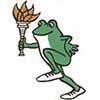 He was honored a common type of frog in Puerto Rico. The Coqui Frog was the first mascot of all Pan-American Games.
He was honored a common type of frog in Puerto Rico. The Coqui Frog was the first mascot of all Pan-American Games.Mascot of the Pan American Games in Caracas - 1983
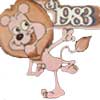 Santiaguito The lion was a tribute to the founder of Caracas, Santiago de Leon. It also symbolizes unity and strength of every country in the Pan
Santiaguito The lion was a tribute to the founder of Caracas, Santiago de Leon. It also symbolizes unity and strength of every country in the PanMascot of the Pan American Games in Indianapolis - 1987
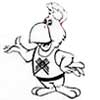 The parrot Friend was chosen to represent a typical bird of the Americas. In addition to inspiring the brotherhood in the countries of the continent.
The parrot Friend was chosen to represent a typical bird of the Americas. In addition to inspiring the brotherhood in the countries of the continent.Mascot of the Pan American Games in Havana - 1991
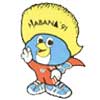 Tocororo is the national bird of Cuba. The Games held in the capital had Tocopan the mascot, the mixture of the bird's name with the name of the event.
Tocororo is the national bird of Cuba. The Games held in the capital had Tocopan the mascot, the mixture of the bird's name with the name of the event.Mascot of the Pan American Games in Mar del Plata - 1995
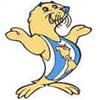 The sea lion was chosen to represent the city of Mar del Plata. Lobi wears a uniform with the colors of Argentina and a map of the Americas.
The sea lion was chosen to represent the city of Mar del Plata. Lobi wears a uniform with the colors of Argentina and a map of the Americas.Mascots of the Pan American Games in Winnipeg - 1999
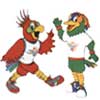 There were two mascots in 1999, the Pan American Duck (crowd favorite) and Lorita Panamericana (a parrot).
There were two mascots in 1999, the Pan American Duck (crowd favorite) and Lorita Panamericana (a parrot).Mascot of the Pan American Games in Santo Domingo - 2003
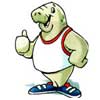 The manatee Titus represents the ecological awareness in the Games. The choice of an endangered animal is a warning to all the Dominican people in the Americas.
The manatee Titus represents the ecological awareness in the Games. The choice of an endangered animal is a warning to all the Dominican people in the Americas.Mascot of the Pan American Games in Rio de Janeiro - 2007
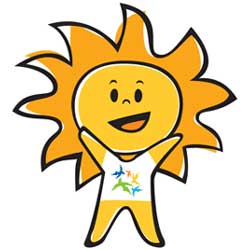 Chosen in popular vote, Cauê is the mascot of the Pan American Games Rio 2007.Cauê mascot was chosen for the 2007 Pan with 465,408 (38% of votes). Kuar got 388,404 (32%) and Luca had 372,751 (30%).
Chosen in popular vote, Cauê is the mascot of the Pan American Games Rio 2007.Cauê mascot was chosen for the 2007 Pan with 465,408 (38% of votes). Kuar got 388,404 (32%) and Luca had 372,751 (30%).What does Cauê?Cauê originates in the salutation "Aue" in Tupi, can also mean "good man". Cauê is part of a legend of the mixture of races and the history of Rio de Janeiro. Cauê was the son of a French woman (Amanda) with the chief Macaw. The choice of the Sun as a mascot was to represent the spirit of Rio and Brazil's tropical climate. The other pets were meant to represent the Brazilian culture. Luca is "light" in Latin and Kuar means "sun" in Guarani.
How was the election that chose the name Cauê Mascot Pan American Games Rio 2007?The poll was conducted between July 13 and August 4 via the Internet, the polls in eight capitals (Rio, Sao Paulo, Belo Horizonte, Brasilia, Recife, Porto Alegre, Florianópolis and São Luís) and text message on mobile phones. The election result was announced in Corcovado, one of the major postcard of Rio de Janeiro.
Learn more:• Cauê - mascot of the 2007 Pan American Games
Mascot of the Pan American Games Guadalajara 2011
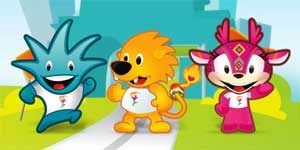
Gavo (a blue agave plant), Huichi (a deer) and Leo (lion) are the mascots of the Pan American Games Guadalajara 2011.
Retirado em: http://quadrodemedalhas.com/jogos-pan-americanos/mascotes-dos-jogos-pan-americanos.htm



